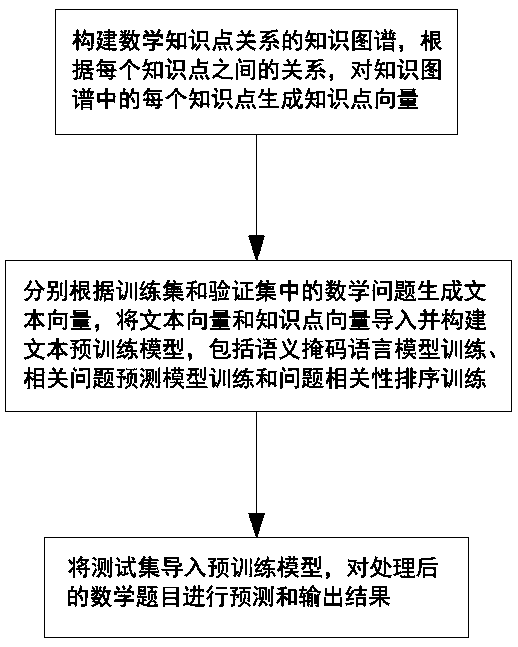Pre-training model method for mathematical problem classification
A problem classification and pre-training technology, which is applied in the field of pre-training models for mathematical problem classification, can solve problems such as inaccurate prediction results, and achieve the effect of enhancing knowledge point representation, improving accuracy, and accurate prediction results
- Summary
- Abstract
- Description
- Claims
- Application Information
AI Technical Summary
Problems solved by technology
Method used
Image
Examples
Embodiment 1
[0036] Such as figure 1 As shown, a pre-training model method for mathematical problem classification includes the following steps:
[0037] Construct a knowledge map of the relationship between mathematical knowledge points, and generate a knowledge point vector for each knowledge point in the knowledge map according to the relationship between each knowledge point;
[0038] Generate text vectors according to the mathematical problems in the training set and verification set respectively, import the text vectors and knowledge point vectors and build a text pre-training model, including semantic mask language model training, related question prediction model training and question relevance ranking training;
[0039] Import the test set into the pre-trained model, predict and output the processed math questions.
[0040] The invention integrates the knowledge map, and proposes a novel masking and prediction strategy to enhance the representation of knowledge points, so that th...
Embodiment 2
[0042] A pre-training model method for classification of mathematical problems, comprising the following steps:
[0043] Construct a knowledge map of the relationship between mathematical knowledge points, and generate a knowledge point vector for each knowledge point in the knowledge map according to the relationship between each knowledge point; where the knowledge map is a graph used to describe the relationship between various knowledge points , the relationship between knowledge points is represented by triples (knowledge point-relationship-knowledge point), and there are three kinds of relationships: containment, belonging, and correlation. In the knowledge graph, each node is a knowledge point, and each edge is a relationship. It can understand various relationships in practical problems from the semantic level, and the description ability is relatively strong. In order to solve multi-relational data, triplet relations in knowledge graphs can be transformed into vector ...
PUM
 Login to View More
Login to View More Abstract
Description
Claims
Application Information
 Login to View More
Login to View More - R&D
- Intellectual Property
- Life Sciences
- Materials
- Tech Scout
- Unparalleled Data Quality
- Higher Quality Content
- 60% Fewer Hallucinations
Browse by: Latest US Patents, China's latest patents, Technical Efficacy Thesaurus, Application Domain, Technology Topic, Popular Technical Reports.
© 2025 PatSnap. All rights reserved.Legal|Privacy policy|Modern Slavery Act Transparency Statement|Sitemap|About US| Contact US: help@patsnap.com

